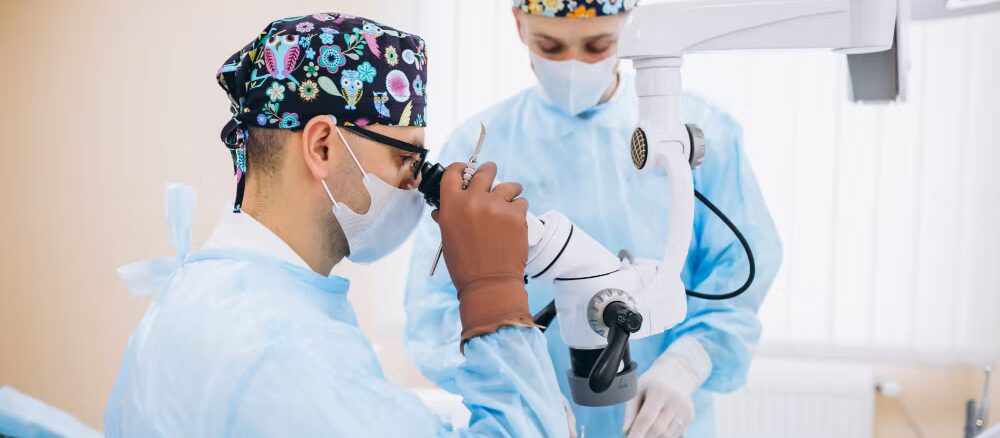Robotic vs. Laparoscopic Surgery: Which is better?
Selecting the best surgical procedure can be difficult with today’s advanced medical technology; patients frequently face this question that “Should I go with laparoscopic or robotic surgery?” Although the fact that both are regarded as low intrusive. If you’re going through any abdominal and pelvic issues and are confused between laparoscopic or robotic surgery, let’s explore why laparoscopic surgery is best for you.Understanding Laparoscopic Surgery
Laparoscopic surgery, commonly referred to as keyhole surgery, which is a less intrusive technique that allows surgeons to operate through small cuts. The surgeon can see the organs inside clearly on a display, which carefully directs all of their movements. This technique has changed surgical operations and is now suggested for a number of surgeries, such as gallbladder removal, cyst repair, and gynaecological treatments. This method is now suggested for a number of surgeries, like:- Gallbladder removal
- Cyst repair
- Appendectomy
- Gynaecological surgery
- Colon and bowel surgery
How does laparoscopic surgery work?
- Small Incisions: The surgeon makes two to three little cuts in the abdomen rather than a major cut.
- Carbon Dioxide Inflation: Carbon dioxide gas is pumped into it to provide the abdomen space.
- Laparoscope insertion: One incision is used to insert a tiny tube equipped with a high-resolution camera.
- Surgical Tools: To carry out the surgery, further instruments are put in via the remaining wounds.
- Monitoring on screen: To enable extremely accurate movements, the surgeon keeps a close eye on everything on a monitor in real time.
Key Benefits of Laparoscopy: Small Cuts, Fast Recovery, Less Pain
There are several valid reasons why laparoscopy is so common; the following are the main advantages:- Less Injury: Scars from the small cuts of operation are less visible.
- Short-term hospitalization: Mostly patients are discharged within a few days based on their condition.
- Quickly recover: Recover faster and get back to your normal state within a few days after operation.
- Pain relief in post-operation: Less pain and trouble with small wounds.
- Lower probability of infection: The chances of infection are lower as exposure of internal organs is less.
- More Affordable: Most of the patients can afford laparoscopic surgery because it is less costly than robotic surgery.
What is Robotic Surgery?
Robotic surgery is a recent type of minimally intrusive surgery; the surgeon uses a robotic console to do the procedure. A 3D camera and computer are used to direct the robot device’s mechanical arms, which restrict the operator’s hand movements in actual time. Despite being highly technologically advanced, it has drawbacks and is very expensive.How does robotic surgery help you?
The following are some major advantages of robotic surgery:- Enhanced Quality: for delicate surgeries, robotic arms provide finely tuned control.
- 3D Visualisation: A full, high-definition view is provided by the system.
- Less hand movements: Unintentional shaking is eliminated using robotic devices.
- The surgeon maintains authority, as the robot is not self-sufficient.
- This level of support is not required for all surgeries.
- Robotic systems are not generally accessible and are costly.
| Features | Laparoscopic Surgery | Robotic Surgery |
|---|---|---|
| Cost | Affordable | Expensive |
| Incision | Small | Small |
| Setup Time | Moderate | High |
| Availability | Widely Available in Hospitals | Available in Select Facilities |
What If Surgery Could Be Painless and Precise? Let’s Talk about Laparoscopy
Patients hope for three things during their surgery:
- Less trouble
- Fast recovery
- Reliable outcomes
Laparoscopic surgery aims to achieve the same objectives. This method helps to reduce harm in many surgeries by the use of small incisions and advanced imaging.
Here’s why it’s frequently seen as a wise, patient-friendly choice:
- Minimally Invasive: Less stress is placed on the body by smaller incisions, which may promote quicker healing.
- Less penetrating: Fewer tubes are inserted in the body by small cuts which helps in fast recovery.
- Budget-friendly care: It is generally more affordable than robotic surgeries since there’s no need for complex robotic systems.
- High accuracy: Surgeons can perform accurate operations.
- Quick return to daily life: Depending on the surgery, many patients return to daily activities in a couple of days.
Still Unsure? Here’s Why We Recommend Laparoscopy First
Both laparoscopic and robotic surgeries have advanced the way healthcare is delivered today. Each method has specific uses, and the optimum strategy is determined by the patient’s condition, the level of difficulty of the therapies, and the eventual goals. However, laparoscopic surgery frequently emerges as a dependable and well-rounded option for a large number of regular and somewhat challenging surgeries.
Medical teams, including those at DP Bora Hospital, frequently suggest laparoscopy as the first line of treatment for the following reasons:
- Commonly used: A lot of hospitals provide laparoscopic operations, which are performed by expert surgical teams.
- Least disruptive method: Involves working through minor cuts with advanced tools and a camera.
- Accessible options: Compared to robotic systems, laparoscopy usually requires less advanced tools, which could lead to variations in cost or resource requirements.
- Post-operative considerations: Less tissue disruption is frequently linked to fewer incisions. However, recovery times can differ based on the patient and the operation.
Every case is evaluated separately at DP Bora Hospital, and the surgical approach is selected in accordance with patient demands and clinical criteria. Laparoscopic surgery is seen as a safe and appropriate first-line option for a variety of surgeries
Final words
Laparoscopic and robotic surgery are both reputable medical treatments, and each of them offers benefits of its own. Laparoscopic surgery is a dependable and affordable alternative that satisfies patients needs without sacrificing outcomes for a number of frequent operations.
Discussing your options for laparoscopic surgery in Lucknow with the skilled staff at DP Bora Hospital is a good idea. We want to give you treatment that is not only efficient but also moral, open, and focused on your health.
Give yourself the clarity and confidence to start your path to improve health.


